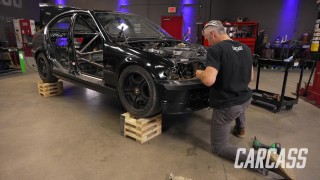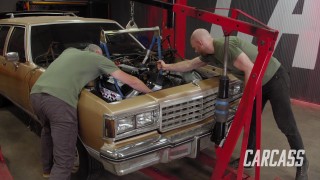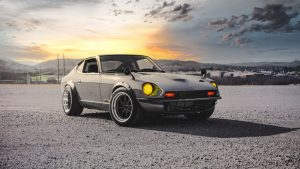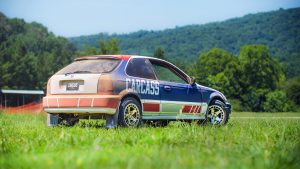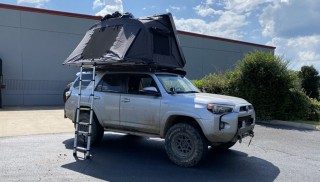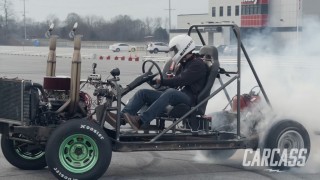Carcass Featured Projects
Carcass Builds
Want more content like this?
Join the PowerNation Email NewsletterEpisode Transcript
(Jimmy)>> You're watching Powernation!
(Jeremy)>> Today on Carcass we're on a mission to Driveway Rescue a car that will be our next project. We'll diagnose some issues and then get it back on the road.
(Jimmy)>> Then surprise Pat and Frankie with a unique dyno session, and finally start tearing out the old stuff to make way for the new. [ Music ] [ tires squealing ] [ Music ]
(Jimmy)>> Hey guys, welcome to Carcass. Today we're going stuff a little bit different and as you can see we're not in the shop, and that's because we're doing a driveway rescue but to find one of our own projects. So we're going to look at a car to see what we can do with it.
(Jeremy)>> Yeah we got a line on a car that had run at one point. The guy parked it and now it doesn't run anymore. He's tried it a couple of times. So we're doing a ran when parked type of thing and a driveway rescue for ourselves. So we got a whole bunch of parts from RockAuto dot com. We're gonna see if we can get this thing running and then we'll try to get it back to the shop.
(Jimmy)>> Yeah it's funny because despite how popular these cars are and how much aftermarket support there is neither you or I have ever done one like in our personal lives like doing projects, and it's never been done on the show. So this should be pretty cool because these cars, I've driven a couple of them and they're super fun, and they're cheap, and you can't really go wrong with them.
(Jeremy)>> It's amazing at how many of those cars are actually out there. They're all over the place. This particular body style we had some trouble trying to hunt one down but we did find one that's in basically stock form, which was even more difficult. But yeah, this should be a fun, fun project, and we'll get it back to the shop and see what we can do with it. And at that point that's probably when we'll let you guys know exactly what the plans are for the car, but here shortly you'll see what kind of car it is.
(Jimmy)>> Yeah I'm pumped! [ Music ] There it is!
(Jeremy)>> There she be. That's what we were looking for.
(Jimmy)>> Let's check it out.
(Jeremy)>> It is stock.
(Jimmy)>> Minus the paint.
(Jeremy)>> It's got a good look to it. Somebody had some fun with the rattle can.
(Jimmy)>> Pretty standard Honda stuff.
(Jeremy)>> The guys did say that it ran when he parked it but supposedly it doesn't run anymore.
(Jimmy)>> Let's just check the fluids in it, and then we can crank it and see if we notice anything, hear anything, whatever.
(Jeremy)>> Get the hood open. This is a unique way to open the hood. That's classic!
(Jimmy)>> Okay it's a little dirty. Got oil leaking form somewhere.
(Jeremy)>> It was red at some point.
(Jimmy)>> Not a huge deal. We'll just check everything over.
(Jeremy)>> Make sure we've got oil in it.
(Jimmy)>> See if she cranks.
(Jeremy)>> See if there's any coolant in it. Looks like there's coolant in it. So we should be alright.
(Jimmy)>> Literally nothing in there. Alright, need some oil! [ Music ] Alright, got the good stuff. [ Music ] Between the dots, good enough.
(Jeremy)>> Fluid's good!
(Jimmy)>> Yeah let's just see if it'll crank.
(Jeremy)>> See what happens. [ engine cranking ]
(Jeremy)>> Nothing!
(Jimmy)>> Alright well let's just start checking if there's fuel, and spark, and all that stuff.
(Jeremy)>> We'll start under the hood I guess. [ Music ] Alright I'll crank it.
(Jimmy)>> To check for spark we're using our Matco inline spark tester. That's good.
(Jeremy)>> Got spark?
(Jimmy)>> Yep!
(Jeremy)>> I'm sure we've got compression. So the next thing I guess is fuel.
(Jimmy)>> We can see if the injectors are getting voltage to them, and then if not take it from there. Alright hold on one second I'll tell you when. To check for injector pulse we'll use a noid light from Matco Tools.
(Jeremy)>> You're good. Okay got an injector pulse then. Suppose we just check the fuel pump next. See if we even have fuel up here.
(Jimmy)>> We should be able to hear it when you turn the key on.
(Jeremy)>> That's back underneath the seat.
(Jimmy)>> Let me put these away and I'll help you out.
(Jeremy)>> Let's see what we got in the small little car here. Best part about these little Hondas is to get to the fuel pump it's all underneath the seat here. So we don't have to crawl underneath the car to do any of this. It's right underneath there. [ Music ] Get this off of here and we'll test to see if we've got power down here at the connector. Start with that. Let's see if we've got voltage. Yep, we've got voltage here. Let's put a pump in it. [ Music ] [ drill humming ] [ Music ]
(Jeremy)>> We iron out a few more problems before we get our Honda on the road again.
(Jeremy)>> Alright now we'll just pull this one down. We'll throw on the new pump that we picked up from RockAuto. [ Music ] There we go! Hose clamp off that's in here. Looks like we got a little friend joining us today. Chickens, what you doing? All the parts your chicken will ever need, Rock Auto.
(Jimmy)>> While Jeremy's taking care of the fuel pump I'm gonna throw in some of the Seafoam high mileage motor treatment. This stuff is specifically formulated for vehicles with over 75,000 miles and our Honda has over 281,000 on the odometer. So it could use some help, and this stuff works in fuel and oil system to help clean and lubricate, and this stuff will help clean our injectors. [ Music ]
(Jeremy)>> Slide this back in the housing here. Put the connector back in it. We're all set.
(Jimmy)>> While Jeremy's taking care of the fuel pump I'm gonna replace the spark plugs. The ones that I'm taking out don't look too bad but just to make sure we're not chasing ghosts it's best to replace them. [ Music ] Just like all our other parts we got our spark plugs from Rock Auto dot com. It's also a good idea when you get new spark plugs to check the gap, and most cars under the hood there will be a catalyst sticker and that'll actually tell you what the gap is. These ones are just about right out of the box. [ Music ] Alright just pop the plug wires in we'll be good to go. Alright it's also a good idea to check the air filter. With this thing sitting so long there might be some mice that built a nest in there or something. Hopefully not. We'll see what we get. A little bit dirty. We got a new one from Rock Auto anyway. So we'll go ahead and replace it. Nice and clean. [ Music ] Alright Jeremy I'm good up here.
(Jeremy)>> You got it taken care of?
(Jimmy)>> Just let me get these tools off here.
(Jeremy)>> I think we can try to fire this thing up. Hopefully it was that simple. Let's see what happens. [ engine starts ]
(Jimmy)>> Nice, alright! I wonder if it'll move. [ engine revving ]
(Jeremy)>> Here we go. Take this thing for a little rip huh?
(Jimmy)>> Yeah just goose it once. [ engine revving ]
(Jeremy)>> Wow, that's four cylinders of raw horsepower.
(Jimmy)>> These things are fun though. One of my buddies in high school he had a CRX, which is a very similar platform, and he would let me drive that thing once in a while and they're just like a little slot car. One day we were in the parking lot at our high school trying to go to lunch and of course there's only two entrances and two exits, and it was a mad house. Like 100 cars behind us or whatever it was and something broke, and he couldn't get it out of gear into neutral. So he had to just step on the clutch and I had to push him out of the way of all these cars, and then the next weekend we went to a pick and pull, which is like a pick your part or whatever, and we went and got a transmission for it. And then he put it in and the car was good.
(Jeremy)>> They're quite simple to work on actually.
(Jimmy)>> Cheap, simple, and the funny thing is that in probably the last 10 years the prices haven't changed that much.
(Jeremy)>> They've kinda just held their value.
(Jimmy)>> Like a 200,000 mile Honda Civic 10 years ago probably costs about the same. Like $3,000 grand, $3,000 to $4,000.
(Jeremy)>> And dealing with Rock Auto and getting all the parts from them super simple. All you've got to do is jump online, order your stuff up. It takes a couple of days for you to get it and you can just put whatever you need in your car. Stuff as simple as oil change stuff. If you've got to do any hard parts like wheel bearings or axle shafts, or struts.
(Jimmy)>> And it's nice too because the Hondas there's a few different chassis'. So just clicking through the menus makes it real easy. Make sure you get the right part for your actual car.
(Jeremy)>> They break it all down to chassis', and engines, and transmissions, automatics or manuals. It's a good easy website to navigate, which is kinda hard to come by every now and again.
(Jimmy)>> We slap the rev limiter in our Civic trying for all the horses that this little four banger has.
(Jeremy)>> Bring her in Jimmy. [ engine revving ]
(Frankie)>> What the heck is this doing here.
(Jeremy)>> We brought you a car.
(Jimmy)>> New project.
(Frankie)>> If you can call it that.
(Pat)>> I heard it driving through and I thought it was the paper boy's moped that had the muffler fall off it.
(Jeremy)>> This is four cylinders of raw horsepower, all four of them.
(Pat)>> Okay this a V-tec car?
(Jimmy)>> Nope, single overhead cam. It's a D-16, which means a 1.6 liter from the factory, maybe 105, 110 horsepower.
(Jeremy)>> Yeah it's all there.
(Pat)>> What's the plan for it?
(Jimmy)>> So this started as our driveway rescue, and even though it's rattle can black like every other Honda out there this thing is like bone stock. So that's what we were looking for, and now we're gonna turn it into a rally car.
(Jeremy)>> We've got some plans for it under the hood type stuff down the way, but we want to get a baseline horsepower number. So that's where you guys come into play.
(Pat)>> I kinda bag on these cars a lot but the bottom line is if you're modifying a car and someone's working on a car I can really appreciate that. I don't care what kind of a car it is. If you're moding it and you're having fun that's what drives this industry forward. Stuff like this I have literally zero experience with. So I guess the first thing is to get it up on the roller to see what it makes. What do you think its gonna make?
(Jimmy)>> 88.
(Jeremy)>> Even 100.
(Pat)>> Optimistic on that one.
(Frankie)>> Probably like 85.
(Pat)>> I'm hoping it'll make 80. I'm the low guy on that one but I don't know anything about them. So strap her up on the old roller and pop the hood. I want to take a look at the engine.
(Jeremy)>> Winner gets a Coke. Yeah right there, that's perfect.
I got it!
(Pat)>> This is actually a relatively clean looking rig.
(Jeremy)>> We've got some oil leaks but we'll take care of those.
(Jimmy)>> It's got oil in it.
(Jeremy)>> We're just here to find out what kind of power it makes.
(Pat)>> Get a tach rigged there. Alright light it. Brake is off. Okay just creep it into gear good, nice and easy.
(Frankie)>> Pretty good for first time.
(Pat)>> Whenever you want to start punch your green button and run it as high you want. [ engine revving ]
(Pat)>> Alright!
(Jimmy)>> We were over 100 miles an hour!
(Jeremy)>> Wait, what did he spin r-p-m's to?
(Pat)>> 6,000.
(Jeremy)>> It sounded like 6 million.
(Pat)>> Official number 91.55.
(Jeremy)>> Nicely done. That was only the first pull. We can go up more than that.
(Pat)>> It made 99.78 pound feet of torque. I am thoroughly impressed.
(Jimmy)>> That was enough to rip the plasti-dip off the tires.
(Pat)>> It wasn't that bad.
(Jeremy)>> It sounded like it was gonna come apart. Not in a bad way but r-p-m's sound way different in a four cylinder.
(Pat)>> It made peak power at 5,500. It's not gonna make any more power over 6,000, but that is pretty cool. It's a little notchy but I didn't know what to expect on this thing. Do another one. When that thing popped at the end I about ran. [ engine revving ]
(Jeremy)>> You literally blew the plasti-dip off that time.
(Pat)>> I panicked for a sec there. 93! We can make 18 more pulls on it until it breaks 100 I guess. At some point it looks like you're gonna run out of gas.
(Jimmy)>> Yeah we're a little low.
(Pat)>> That was spicy.
(Jimmy)>> That was cool!
(Jeremy)>> We got a good base line. We know where we're gonna start. Once we get done underneath the hood. We're not gonna tell you what we're gonna do. We're gonna bring it back and we'll do it all over again.
(Pat)>> That's cool!
(Frankie)>> Bring it back and we'll see.
(Jeremy)>> We're gonna take care of the engine stuff this time. It's not major but we're gonna take care of it.
(Pat)>> The nice part about these there's tons and tons of parts available for them, and for what you're doing, rally car stuff. That's what I used to do on a very amateur scale back in Michigan. Going through the woods with cars like this. They were rear wheel drive American cars but this is gonna be cool. I really like this. It's all in one piece and that's always a win.
(Jeremy)>> Lets get it unstrapped and we'll go back to work down there.
(Jimmy)>> Let's do it.
(Jeremy)>> Coming up, we start tearing into our Honda to make room for some big plans.
(Jeremy)>> Alright bring that back in here. Yeah that's good enough. Right there will work. You know the way that you were revving this thing when you were on the dyno I thought you were gonna shoot to the moon and back.
(Jimmy)>> It's just funny because this thing makes so much noise for being so tiny and it faces the wrong way on the dyno.
(Jeremy)>> If you guys haven't picked up by now when we were down talking to Frankie and Pat we're gonna be turning this thing into a little rally car.
(Jimmy)>> And the way we're gonna do that is we're gonna start on the interior fitting up some racing seats and a roll cage. Then we'll go up front and add some power in the form of a turbo kit, and we'll throw up some axles to help strengthen everything up, and then we will add in some rally specific coil overs to make this thing handle on the course.
(Jeremy)>> At the very end we're gonna toss on a very specific set of wheels and tires for rally cross, and then we're gonna run this thing around the course, but I think we should just dive inside and get rid of all the interior. We'll make way for those new seats and that roll cage.
(Jimmy)>> Let's rip it out.
(Jeremy)>> Somebody's been in here already.
(Jimmy)>> Lot of trash in here too. [ Music ] [ drill humming ]
(Jimmy)>> A doughnut, that's tiny. I mean these are already tiny. [ drill humming ]
(Jimmy)>> Those are ready to come out. Coming out I guess.
(Jeremy)>> Are they the plastic insert ones?
(Jimmy)>> Yeah they're kinda junk.
(Jeremy)>> Can it go your way? Right on the seatbelt. That's a giant piece of plastic. [ Music ] That's a dash! [ Music ] Alright we're ready. Yeah that's nasty stuff! You take it, I don't want it. Wait we've got some wires. Alright you're good. [ Music ] Alright check this out. You know we ripped out the entire interior but I did a little bit of wiring and it still runs.
(Jimmy)>> That's good because we know we didn't rip out anything we didn't need, and now we can start getting to fitting our seats and putting the cage in.
(Jeremy)>> Yeah but I think that pretty much wraps it up for us today. If you guys want more information on the show or if you're interested in the parts that we put in the Honda to get it running why don't you go to Powernation TV dot com.
(Jimmy)>> And while you're there go ahead and check out our project pages where you can get full build details on past projects like the tow truck and Project Junk Mail, and even current projects like our Civic.
(Jeremy)>> What do you think we start cleaning up?
Show Full Transcript
(Jeremy)>> Today on Carcass we're on a mission to Driveway Rescue a car that will be our next project. We'll diagnose some issues and then get it back on the road.
(Jimmy)>> Then surprise Pat and Frankie with a unique dyno session, and finally start tearing out the old stuff to make way for the new. [ Music ] [ tires squealing ] [ Music ]
(Jimmy)>> Hey guys, welcome to Carcass. Today we're going stuff a little bit different and as you can see we're not in the shop, and that's because we're doing a driveway rescue but to find one of our own projects. So we're going to look at a car to see what we can do with it.
(Jeremy)>> Yeah we got a line on a car that had run at one point. The guy parked it and now it doesn't run anymore. He's tried it a couple of times. So we're doing a ran when parked type of thing and a driveway rescue for ourselves. So we got a whole bunch of parts from RockAuto dot com. We're gonna see if we can get this thing running and then we'll try to get it back to the shop.
(Jimmy)>> Yeah it's funny because despite how popular these cars are and how much aftermarket support there is neither you or I have ever done one like in our personal lives like doing projects, and it's never been done on the show. So this should be pretty cool because these cars, I've driven a couple of them and they're super fun, and they're cheap, and you can't really go wrong with them.
(Jeremy)>> It's amazing at how many of those cars are actually out there. They're all over the place. This particular body style we had some trouble trying to hunt one down but we did find one that's in basically stock form, which was even more difficult. But yeah, this should be a fun, fun project, and we'll get it back to the shop and see what we can do with it. And at that point that's probably when we'll let you guys know exactly what the plans are for the car, but here shortly you'll see what kind of car it is.
(Jimmy)>> Yeah I'm pumped! [ Music ] There it is!
(Jeremy)>> There she be. That's what we were looking for.
(Jimmy)>> Let's check it out.
(Jeremy)>> It is stock.
(Jimmy)>> Minus the paint.
(Jeremy)>> It's got a good look to it. Somebody had some fun with the rattle can.
(Jimmy)>> Pretty standard Honda stuff.
(Jeremy)>> The guys did say that it ran when he parked it but supposedly it doesn't run anymore.
(Jimmy)>> Let's just check the fluids in it, and then we can crank it and see if we notice anything, hear anything, whatever.
(Jeremy)>> Get the hood open. This is a unique way to open the hood. That's classic!
(Jimmy)>> Okay it's a little dirty. Got oil leaking form somewhere.
(Jeremy)>> It was red at some point.
(Jimmy)>> Not a huge deal. We'll just check everything over.
(Jeremy)>> Make sure we've got oil in it.
(Jimmy)>> See if she cranks.
(Jeremy)>> See if there's any coolant in it. Looks like there's coolant in it. So we should be alright.
(Jimmy)>> Literally nothing in there. Alright, need some oil! [ Music ] Alright, got the good stuff. [ Music ] Between the dots, good enough.
(Jeremy)>> Fluid's good!
(Jimmy)>> Yeah let's just see if it'll crank.
(Jeremy)>> See what happens. [ engine cranking ]
(Jeremy)>> Nothing!
(Jimmy)>> Alright well let's just start checking if there's fuel, and spark, and all that stuff.
(Jeremy)>> We'll start under the hood I guess. [ Music ] Alright I'll crank it.
(Jimmy)>> To check for spark we're using our Matco inline spark tester. That's good.
(Jeremy)>> Got spark?
(Jimmy)>> Yep!
(Jeremy)>> I'm sure we've got compression. So the next thing I guess is fuel.
(Jimmy)>> We can see if the injectors are getting voltage to them, and then if not take it from there. Alright hold on one second I'll tell you when. To check for injector pulse we'll use a noid light from Matco Tools.
(Jeremy)>> You're good. Okay got an injector pulse then. Suppose we just check the fuel pump next. See if we even have fuel up here.
(Jimmy)>> We should be able to hear it when you turn the key on.
(Jeremy)>> That's back underneath the seat.
(Jimmy)>> Let me put these away and I'll help you out.
(Jeremy)>> Let's see what we got in the small little car here. Best part about these little Hondas is to get to the fuel pump it's all underneath the seat here. So we don't have to crawl underneath the car to do any of this. It's right underneath there. [ Music ] Get this off of here and we'll test to see if we've got power down here at the connector. Start with that. Let's see if we've got voltage. Yep, we've got voltage here. Let's put a pump in it. [ Music ] [ drill humming ] [ Music ]
(Jeremy)>> We iron out a few more problems before we get our Honda on the road again.
(Jeremy)>> Alright now we'll just pull this one down. We'll throw on the new pump that we picked up from RockAuto. [ Music ] There we go! Hose clamp off that's in here. Looks like we got a little friend joining us today. Chickens, what you doing? All the parts your chicken will ever need, Rock Auto.
(Jimmy)>> While Jeremy's taking care of the fuel pump I'm gonna throw in some of the Seafoam high mileage motor treatment. This stuff is specifically formulated for vehicles with over 75,000 miles and our Honda has over 281,000 on the odometer. So it could use some help, and this stuff works in fuel and oil system to help clean and lubricate, and this stuff will help clean our injectors. [ Music ]
(Jeremy)>> Slide this back in the housing here. Put the connector back in it. We're all set.
(Jimmy)>> While Jeremy's taking care of the fuel pump I'm gonna replace the spark plugs. The ones that I'm taking out don't look too bad but just to make sure we're not chasing ghosts it's best to replace them. [ Music ] Just like all our other parts we got our spark plugs from Rock Auto dot com. It's also a good idea when you get new spark plugs to check the gap, and most cars under the hood there will be a catalyst sticker and that'll actually tell you what the gap is. These ones are just about right out of the box. [ Music ] Alright just pop the plug wires in we'll be good to go. Alright it's also a good idea to check the air filter. With this thing sitting so long there might be some mice that built a nest in there or something. Hopefully not. We'll see what we get. A little bit dirty. We got a new one from Rock Auto anyway. So we'll go ahead and replace it. Nice and clean. [ Music ] Alright Jeremy I'm good up here.
(Jeremy)>> You got it taken care of?
(Jimmy)>> Just let me get these tools off here.
(Jeremy)>> I think we can try to fire this thing up. Hopefully it was that simple. Let's see what happens. [ engine starts ]
(Jimmy)>> Nice, alright! I wonder if it'll move. [ engine revving ]
(Jeremy)>> Here we go. Take this thing for a little rip huh?
(Jimmy)>> Yeah just goose it once. [ engine revving ]
(Jeremy)>> Wow, that's four cylinders of raw horsepower.
(Jimmy)>> These things are fun though. One of my buddies in high school he had a CRX, which is a very similar platform, and he would let me drive that thing once in a while and they're just like a little slot car. One day we were in the parking lot at our high school trying to go to lunch and of course there's only two entrances and two exits, and it was a mad house. Like 100 cars behind us or whatever it was and something broke, and he couldn't get it out of gear into neutral. So he had to just step on the clutch and I had to push him out of the way of all these cars, and then the next weekend we went to a pick and pull, which is like a pick your part or whatever, and we went and got a transmission for it. And then he put it in and the car was good.
(Jeremy)>> They're quite simple to work on actually.
(Jimmy)>> Cheap, simple, and the funny thing is that in probably the last 10 years the prices haven't changed that much.
(Jeremy)>> They've kinda just held their value.
(Jimmy)>> Like a 200,000 mile Honda Civic 10 years ago probably costs about the same. Like $3,000 grand, $3,000 to $4,000.
(Jeremy)>> And dealing with Rock Auto and getting all the parts from them super simple. All you've got to do is jump online, order your stuff up. It takes a couple of days for you to get it and you can just put whatever you need in your car. Stuff as simple as oil change stuff. If you've got to do any hard parts like wheel bearings or axle shafts, or struts.
(Jimmy)>> And it's nice too because the Hondas there's a few different chassis'. So just clicking through the menus makes it real easy. Make sure you get the right part for your actual car.
(Jeremy)>> They break it all down to chassis', and engines, and transmissions, automatics or manuals. It's a good easy website to navigate, which is kinda hard to come by every now and again.
(Jimmy)>> We slap the rev limiter in our Civic trying for all the horses that this little four banger has.
(Jeremy)>> Bring her in Jimmy. [ engine revving ]
(Frankie)>> What the heck is this doing here.
(Jeremy)>> We brought you a car.
(Jimmy)>> New project.
(Frankie)>> If you can call it that.
(Pat)>> I heard it driving through and I thought it was the paper boy's moped that had the muffler fall off it.
(Jeremy)>> This is four cylinders of raw horsepower, all four of them.
(Pat)>> Okay this a V-tec car?
(Jimmy)>> Nope, single overhead cam. It's a D-16, which means a 1.6 liter from the factory, maybe 105, 110 horsepower.
(Jeremy)>> Yeah it's all there.
(Pat)>> What's the plan for it?
(Jimmy)>> So this started as our driveway rescue, and even though it's rattle can black like every other Honda out there this thing is like bone stock. So that's what we were looking for, and now we're gonna turn it into a rally car.
(Jeremy)>> We've got some plans for it under the hood type stuff down the way, but we want to get a baseline horsepower number. So that's where you guys come into play.
(Pat)>> I kinda bag on these cars a lot but the bottom line is if you're modifying a car and someone's working on a car I can really appreciate that. I don't care what kind of a car it is. If you're moding it and you're having fun that's what drives this industry forward. Stuff like this I have literally zero experience with. So I guess the first thing is to get it up on the roller to see what it makes. What do you think its gonna make?
(Jimmy)>> 88.
(Jeremy)>> Even 100.
(Pat)>> Optimistic on that one.
(Frankie)>> Probably like 85.
(Pat)>> I'm hoping it'll make 80. I'm the low guy on that one but I don't know anything about them. So strap her up on the old roller and pop the hood. I want to take a look at the engine.
(Jeremy)>> Winner gets a Coke. Yeah right there, that's perfect.
I got it!
(Pat)>> This is actually a relatively clean looking rig.
(Jeremy)>> We've got some oil leaks but we'll take care of those.
(Jimmy)>> It's got oil in it.
(Jeremy)>> We're just here to find out what kind of power it makes.
(Pat)>> Get a tach rigged there. Alright light it. Brake is off. Okay just creep it into gear good, nice and easy.
(Frankie)>> Pretty good for first time.
(Pat)>> Whenever you want to start punch your green button and run it as high you want. [ engine revving ]
(Pat)>> Alright!
(Jimmy)>> We were over 100 miles an hour!
(Jeremy)>> Wait, what did he spin r-p-m's to?
(Pat)>> 6,000.
(Jeremy)>> It sounded like 6 million.
(Pat)>> Official number 91.55.
(Jeremy)>> Nicely done. That was only the first pull. We can go up more than that.
(Pat)>> It made 99.78 pound feet of torque. I am thoroughly impressed.
(Jimmy)>> That was enough to rip the plasti-dip off the tires.
(Pat)>> It wasn't that bad.
(Jeremy)>> It sounded like it was gonna come apart. Not in a bad way but r-p-m's sound way different in a four cylinder.
(Pat)>> It made peak power at 5,500. It's not gonna make any more power over 6,000, but that is pretty cool. It's a little notchy but I didn't know what to expect on this thing. Do another one. When that thing popped at the end I about ran. [ engine revving ]
(Jeremy)>> You literally blew the plasti-dip off that time.
(Pat)>> I panicked for a sec there. 93! We can make 18 more pulls on it until it breaks 100 I guess. At some point it looks like you're gonna run out of gas.
(Jimmy)>> Yeah we're a little low.
(Pat)>> That was spicy.
(Jimmy)>> That was cool!
(Jeremy)>> We got a good base line. We know where we're gonna start. Once we get done underneath the hood. We're not gonna tell you what we're gonna do. We're gonna bring it back and we'll do it all over again.
(Pat)>> That's cool!
(Frankie)>> Bring it back and we'll see.
(Jeremy)>> We're gonna take care of the engine stuff this time. It's not major but we're gonna take care of it.
(Pat)>> The nice part about these there's tons and tons of parts available for them, and for what you're doing, rally car stuff. That's what I used to do on a very amateur scale back in Michigan. Going through the woods with cars like this. They were rear wheel drive American cars but this is gonna be cool. I really like this. It's all in one piece and that's always a win.
(Jeremy)>> Lets get it unstrapped and we'll go back to work down there.
(Jimmy)>> Let's do it.
(Jeremy)>> Coming up, we start tearing into our Honda to make room for some big plans.
(Jeremy)>> Alright bring that back in here. Yeah that's good enough. Right there will work. You know the way that you were revving this thing when you were on the dyno I thought you were gonna shoot to the moon and back.
(Jimmy)>> It's just funny because this thing makes so much noise for being so tiny and it faces the wrong way on the dyno.
(Jeremy)>> If you guys haven't picked up by now when we were down talking to Frankie and Pat we're gonna be turning this thing into a little rally car.
(Jimmy)>> And the way we're gonna do that is we're gonna start on the interior fitting up some racing seats and a roll cage. Then we'll go up front and add some power in the form of a turbo kit, and we'll throw up some axles to help strengthen everything up, and then we will add in some rally specific coil overs to make this thing handle on the course.
(Jeremy)>> At the very end we're gonna toss on a very specific set of wheels and tires for rally cross, and then we're gonna run this thing around the course, but I think we should just dive inside and get rid of all the interior. We'll make way for those new seats and that roll cage.
(Jimmy)>> Let's rip it out.
(Jeremy)>> Somebody's been in here already.
(Jimmy)>> Lot of trash in here too. [ Music ] [ drill humming ]
(Jimmy)>> A doughnut, that's tiny. I mean these are already tiny. [ drill humming ]
(Jimmy)>> Those are ready to come out. Coming out I guess.
(Jeremy)>> Are they the plastic insert ones?
(Jimmy)>> Yeah they're kinda junk.
(Jeremy)>> Can it go your way? Right on the seatbelt. That's a giant piece of plastic. [ Music ] That's a dash! [ Music ] Alright we're ready. Yeah that's nasty stuff! You take it, I don't want it. Wait we've got some wires. Alright you're good. [ Music ] Alright check this out. You know we ripped out the entire interior but I did a little bit of wiring and it still runs.
(Jimmy)>> That's good because we know we didn't rip out anything we didn't need, and now we can start getting to fitting our seats and putting the cage in.
(Jeremy)>> Yeah but I think that pretty much wraps it up for us today. If you guys want more information on the show or if you're interested in the parts that we put in the Honda to get it running why don't you go to Powernation TV dot com.
(Jimmy)>> And while you're there go ahead and check out our project pages where you can get full build details on past projects like the tow truck and Project Junk Mail, and even current projects like our Civic.
(Jeremy)>> What do you think we start cleaning up?







